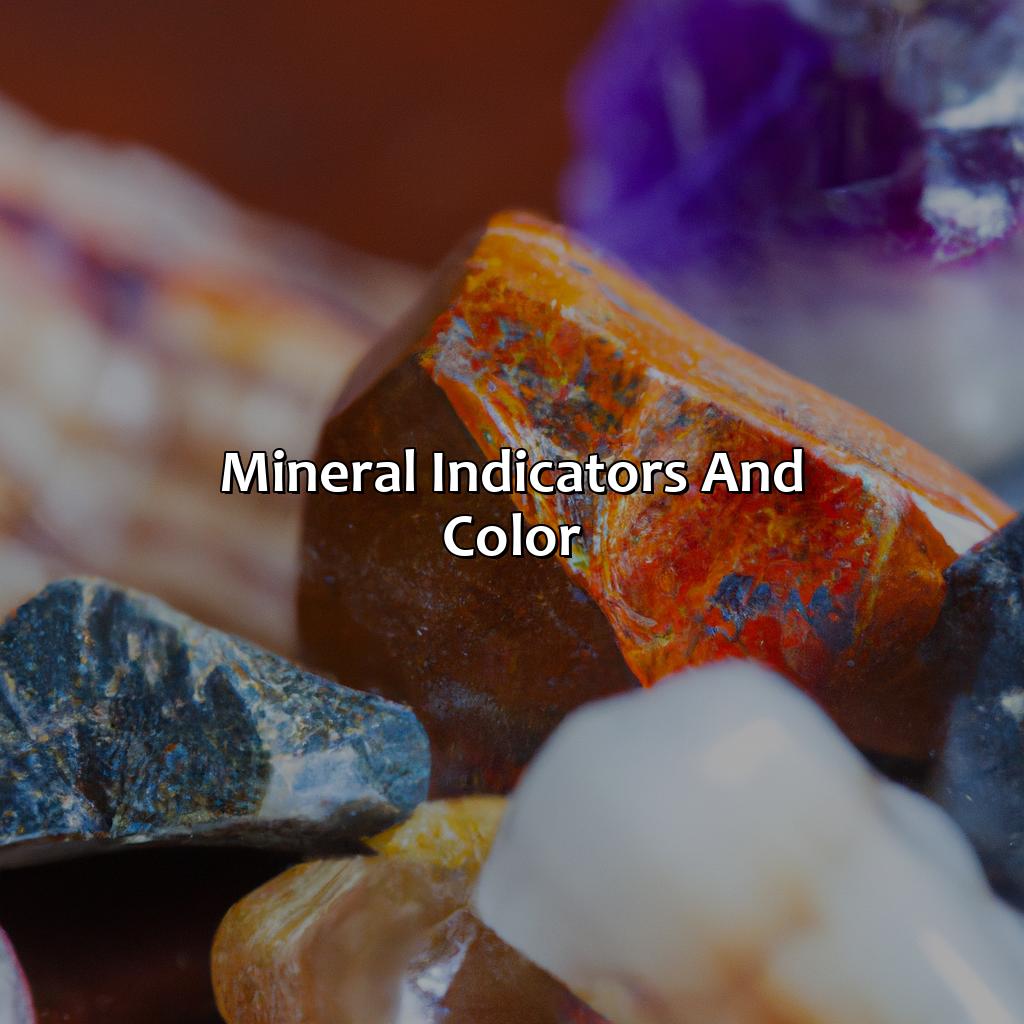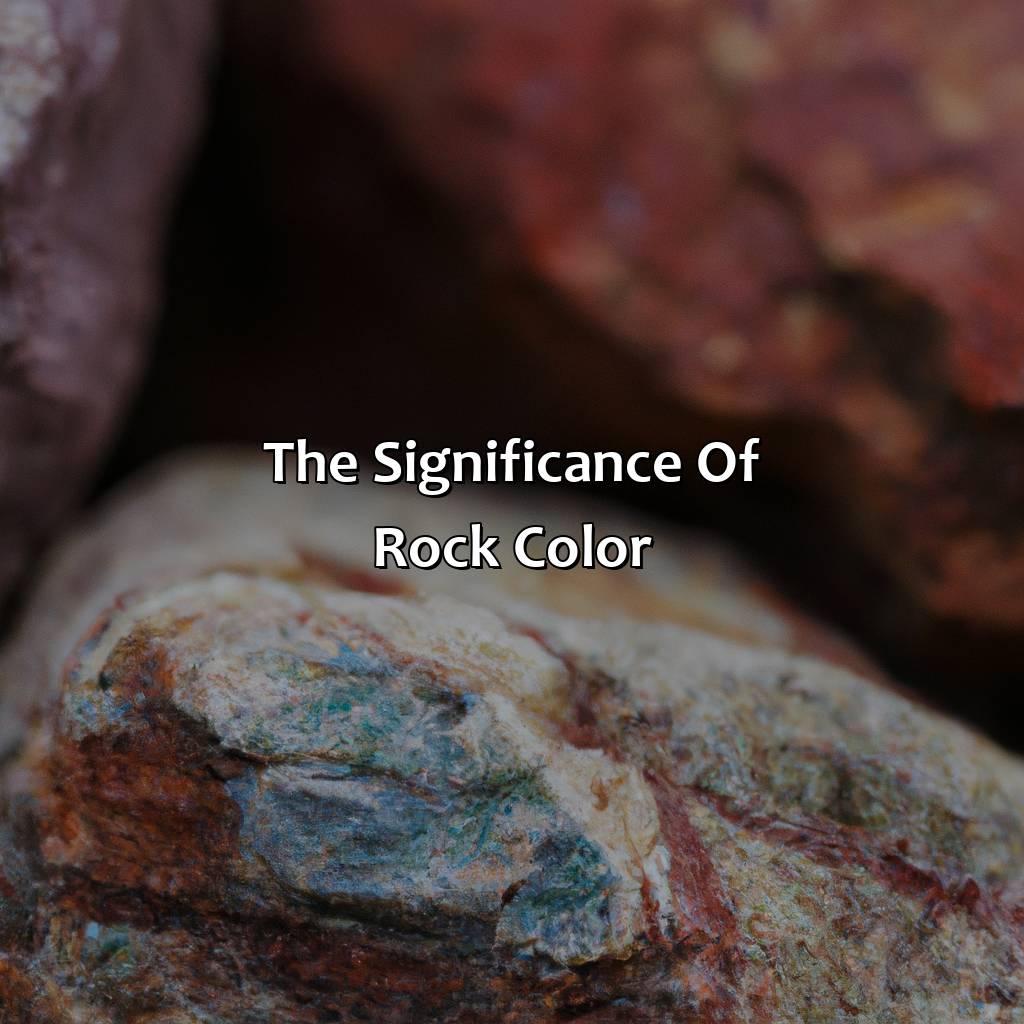Key Takeaway:
- The color of rocks is determined by a combination of factors, including their mineral composition, chemical structure, light absorption and reflection, environmental exposure, and geologic history.
- Minerals are the building blocks of rocks, and the color of a rock is often dictated by the minerals it contains. Different minerals exhibit different colors due to their chemical composition and crystal structure.
- Mineral indicators can be used to identify different types of rocks and their geologic history, and they can also be used as economic indicators for mineral deposits.
Factors that Determine the Color of Rocks

Photo Credits: colorscombo.com by Elijah Martinez
To comprehend why rocks are colored, delve into geology, minerals, and their chemical composition. Composition and structure of the rock, such as igneous, sedimentary, or metamorphic, and the crystal structure are influential factors. Also, light absorption, reflection, refraction, weathering, erosion, environment, and geologic time affect the color of rocks.
Influential Factors: Composition and Structure
Rocks’ color is influenced by their composition and crystal structure. The type of rock, whether it’s igneous, sedimentary or metamorphic, affects its appearance. The crystal structure’s arrangement also determines a rock’s color.
| Factor | Description |
| Composition | The minerals that make up a rock can vary and affect the overall color. |
| Crystal Structure | The way atoms are arranged can alter how light reflects off the rock. |
Composition plays a critical role in determining color because different minerals produce varying shades due to their chemical makeup. Crystal structure is significant because how light interacts with each mineral differs compared to others. For example, quartz appears milky white since it doesn’t absorb light like other minerals.
It’s intriguing to note that while there are chemical compositions for specific rocks, different types of rock formations can create identical material. Basalt and gabbro have an identical chemical composition but differ in crystal size due to the rate the magma cools.
According to researchers at DePauw University, limestone appears grey or buff-colored because of its content of about ten percent clay-sized sediments’ content. Other factors such as pressure changes cause clay particles to stick together and reduce their reflectivity, creating a darker rock surface.
It’s interesting to know that hematite gives red-brown hues while chlorite indicates green hues in rocks – as referenced by geologists from Iowa State University.
Even rocks need a little sunshine, but too much exposure can cause some serious color fading.
Other Factors: Light and Environmental Exposure
Light and environmental factors play a crucial role in determining the color of rocks. Different wavelengths of light interact differently with minerals, leading to variations in reflection, absorption, and refraction. Moreover, the environmental exposure also alters rock color over time due to weathering and erosion.
| Factors | Description |
| Light Absorption | Different minerals absorb different wavelengths of light which results in variations in rock colors. |
| Reflection | The reflective properties of minerals determine how much visible light is reflected, influencing the appearance of rocks. |
| Refraction | The way that light enters and exits minerals can also affect coloration by altering the wavelength of light. |
| Environmental Factors | Natural factors such as wind, water, temperature changes that have accumulated over geologic time inevitably alter the appearance of rocks. Weathering reactions induced by water (hydrolysis), acid (evolution), or oxidation tend to change the surface coloration. Erosion washes away top layers bringing out underlying rock surfaces that may differ in composition and thus in color. |
It is worth noting that environmental exposure impacts rock colors differently based on various settings such as location, climate or altitude. For instance, rocks exposed to cold temperatures at high altitudes often have stark white hues compared to those found in lower altitudes where they face different seasonal conditions.
The concept of ‘color-index mineral’ considers the relationship between changes in color and the mineralogical composition of rocks. When certain minerals that favor specific colors, such as olivine which is associated with a green hue, get embedded in rocks, the color of the rock changes correspondingly to suit the mineral content.
In different parts of the world, rock coloration may tell stories related to natural phenomena or significant events. For instance, in India’s Jaisalmer district, sandstone’s yellowish color comes from iron oxide clusters formed by ancient bacteria that proliferated when the area was once an ocean floor.
Overall, it is evident that rock coloration is a function of numerous factors confined to geologic time frames and environmental exposure – thereby preserving clues about their formation history.
Rocks may be old, but they still love chemistry class – especially when it comes to reactions and pigments.
The Chemistry of Rock Colors

Photo Credits: colorscombo.com by Eric Brown
To understand why rocks have different colors, explore the Chemistry of Rock Colors. It’s divided into three sections:
- The first covers minerals and their role in color. It looks at mineralogy, identification, crystallography, and luster.
- The second section talks about chemical reactions and ore formation. It covers mineral associations, geochronology, and radiometric dating.
- Finally, the third section looks at weathering and alteration. It looks at soil composition, rock hardness, mineral crystals, inclusions, fracture patterns, and mineral habit to show how natural factors affect a rock’s color.
Understanding the Role of Minerals
The essential factor in rock color is the mineralogy of its constituting minerals. The identification of minerals through their physical properties such as crystallography, luster, and other features plays a crucial role in determining the color of the rock. Minerals exhibit varying spectral qualities when subjected to light radiation and other factors like environmental exposure. The distinctive set of chemical reactions within each mineral leads to different colors. Additionally, variations in composition, structure, and interstitial components can also contribute to color variation.
Get ready to dig deeper into the chemical reactions that have shaped our world – it’s like a geological CSI investigation!
Chemical Reactions
Chemical Transformations in Rocks
Rocks undergo chemical reactions that change their color and composition. These transformations are influenced by geological events such as ore formation, mineral associations, geochronology, radiometric dating, geologic mapping and geological surveys. These reactions can alter the minerals present in the rock structure leading to new colors and textures. Overtime, due to weathering and environmental exposure, rocks break down into different compounds further changing their appearance. Mineralogy database is used to identify these alterations by analyzing the chemical makeup of the sample.
Even rocks can change their appearance over time, proving that even geology can have a midlife crisis.
Weathering and Alteration
The gradual breakdown and alteration of rocks caused by environmental exposure, such as water, wind, and temperature changes, can drastically affect their appearance. This is known as Rock Weathering and Alteration. Over time, the soil composition and rock hardness can weaken due to chemical reactions that transform minerals within the rock, causing it to erode or lose color. Mineral crystals can change shape and size during weathering, which often alters the way light reflects off of them and brings about variations in color. In some cases, mineral inclusions or unreactive chemicals within a rock can make it more vulnerable to fractures caused by external stresses, such as earthquakes or mining activities. These fracture patterns also influence how light interacts with the rock’s surface. In combination with other factors like mineral habit, these alterations ultimately determine a rock’s unique color palette.
Using the power of spectral analysis and mineral fluorescence, we can uncover the true colors of rocks and their hidden mineral pigments.
Mineral Indicators and Color

Photo Credits: colorscombo.com by Austin Jackson
Spectral analysis is one way to understand mineral indicators and colors of rocks. You can also use mineral fluorescence, phosphorescence, and pigments. To identify minerals present in rocks, take a look at colors like veins or deposits. Plus, mineralogical indicators like hematite, calcite, chlorite, feldspar, quartz, tourmaline, and mica can help you determine their features.
Mineral Identification Using Color
The colors of rocks are essential in identifying minerals present therein. The shade variations signify different mineral compositions and structure, which reveal distinct geologic events. Mineral identification through color is the primary method for geologists to determine the origin and distribution of mineral veins or deposits in rock formations.
To identify minerals using colors, geologists observe the hue, saturation, intensity, fluorescence when exposed to ultraviolet light and relationship between adjacent mineral components. For instance, pyrite appears as a yellow-gold metallic color when freshly broken while hematite has red-brown to black-red color. The contrast between these two hues distinguishes iron oxide-rich minerals from basic sulfides in ore deposits.
Mineral identification using color is a crucial step in mineral prospecting and exploration as it helps explain geological formation processes and subsequent alteration events. Furthermore, it guides the selection of sampling locations for follow-up analysis as different colored samples can show variations in composition based on their specific exposure or weather conditions.
For a long time, geologists relied on visual observations of color alone; however, recent advancements in digital imaging technology can provide accurate quantitative data for faster and more reliable identification processes. These technological advances help characterize previously unknown minerals significantly faster than traditional techniques alone.
Historically minerals were identified by their distinctive colors even before modern science emerged through minerology thanks to their differences in electrical conductivity. With chemical tests evolving over many decades scientific understanding about minerals was discovered including how they are formed in vein systems often caused by volcanic activity or weathering occurring over millions of years.
Mineral veins and deposits become evident when deeper layers within the earth’s crust enthalpically evolve and deposit resulting materials closer to the surface within rocks of various colors across continental masses that often occur due to accumulation over long periods due to wind or underwater currents creating patterns worldwide providing clues into Earth’s geological lifespan.
From calcite to tourmaline, minerals hold the key to unlocking the colorful secrets of rocks.
Mineralogical Indicators
Here is a table showing mineral indicators and their corresponding rock types:
| Mineral Indicator | Rock Type |
|---|---|
| Calcite | Limestone |
| Hematite | Iron Formation |
| Chlorite | Schist rock |
| Tourmaline | Pegmatites |
| Feldspar | Granite |
| Quartz | Sandstone |
| Mica | Schist rock |
A closer look at these mineralogical indicators reveals how minerals contribute to the color of a rock. For example, chlorite is responsible for the green color in schist rock. Additionally, multiple minerals may coexist within a single rock and their collective interaction will determine its final hue.
Hematite is one of the main minerals that create red and brown colors in rocks due to oxidation of iron from it. Hematite minerals are among the strongest signatures for hydrothermal alteration that leads to gold deposition.
Tourmaline minerals are often observed in association with granites and pegmatites which are important hosts for ore-forming elements like tin and copper while feldspars help identify places where volcanism has played an influential role in rock formation.
Calcite is a common mineral identified through its white coloration in rocks like limestone which signify deposition in marine environments.
Rock color may symbolize deeper meanings, but let’s not forget its economic value in the world of geology.
The Significance of Rock Color

Photo Credits: colorscombo.com by Thomas Rivera
To grasp the value of rock color in various ways, like color symbolism, geode formation, and economics, one must dive into the geologic history and formation of rocks. This includes comprehending the rock cycle, geological formations, volcanic eruptions, and the contrasts between extrusive rocks, intrusive rocks, and mineral hardness. Besides, one should also be aware of the economic importance of different rocks, such as shale, sandstone, limestone, basalt, granite, obsidian, tuff, and volcanic ash.
Geologic History and Formation
The history of geological formations is pertinent to understanding the color of rocks. The colors of extrusive rocks, formed by volcanic eruptions, are mostly determined by their mineral composition and environment exposure. Intrusive rocks, on the other hand, have distinct compositions that influence their colors during formation. The rock cycle and mineral hardness also contribute to the color of a rock over time.
Rock formation plays an essential role in determining a rock’s final color through its chemical reactions and weathering processes. Over time, minerals experience changes that alter or influence the rock’s original color. For example, oxidation can make iron-rich minerals appear reddish-brown or rust-colored, while certain types of weathering can cause a green color in copper-based minerals.
Geological history can also indicate valuable information about past environmental conditions and provide insights into economic deposits related to specific minerals’ colors. For instance, some geological formations contain sulfur-rich minerals that are integral in producing high-quality fertilizers and batteries. Additionally, geologists use mineral indicators to trace valuable deposits such as gold, silver, or copper.
Pro Tip: A useful method for identifying rocks is examining their texture- this complements analysis based on specific factors which determine their color such as structure and chemistry.
Rock color can determine a lot about its economic value, from the shale that fuels our energy needs to the granite that tops our counters.
Economic Significance
The Economic Benefits of Rock Colors
Different rock colors can be a valuable source of information for geologists, prospectors, and miners. They provide geological clues that can lead to the identification of specific mineral deposits such as gold, silver, copper, and iron. Shale and sandstone are sedimentary rocks with potential oil or gas reservoirs while limestone is rich in calcium carbonate which is useful in construction material. Basalt and granite are igneous rocks with minerals such as pyroxene and olivine that are used in the manufacturing of concrete and road construction. Obsidian an extrusive igneous rock usually black or dark brown in color is valued for its use in knives, arrowheads, and other cutting tools. Tuff, volcanic ash that has compressed into a soft rock-like material, is often used as an abrasive material for surface finishing.
In addition to their inherent economic value, understanding the geologic setting behind rock colors could inform decisions regarding land use planning or environmental assessment involving mining activities. The selection of materials for infrastructure development (e.g., roads), landscaping, construction (e.g., buildings), decorative purposes enhances aesthetics using colorful rocks.
Overall different types of rock colors have considerable economic significance due to their varied uses. It is important to recognize the color patterns so that we can ascertain the extent of their purposeful exploitation while keeping knowledgeable choices on sustainable resource extraction policies regarding these natural Earth material resources.
Five Facts About What Determines The Color Of A Rock:
- ✅ The color of a rock is determined by its mineral composition. (Source: Geology.com)
- ✅ The presence of certain minerals can cause a rock to appear a specific color, such as iron causing a red or orange hue. (Source: Live Science)
- ✅ The texture and structure of a rock can also affect its color, such as rocks with smaller crystal sizes appearing lighter in color. (Source: ThoughtCo)
- ✅ Environmental factors, such as weathering and exposure to sunlight, can alter the color of a rock over time. (Source: Encyclopaedia Britannica)
- ✅ Different regions of the world have unique types of rocks and mineral compositions, resulting in a diverse range of rock colors. (Source: ScienceStruck)
FAQs about What Determines The Color Of A Rock?
What determines the color of a rock?
The color of a rock is determined by a variety of factors, including its mineral content, chemical composition, and how it was formed.
Can the same type of rock come in different colors?
Yes, the same type of rock can come in different colors. This can be due to variations in the mineral content or impurities present in the rock.
Why are some rocks brighter in color than others?
Rocks with bright colors such as red or yellow often contain mineral compounds like iron oxide or sulfur. These minerals reflect light and make the rock appear brighter.
What role does lighting play in the appearance of a rock’s color?
The lighting in an environment can affect the appearance of a rock’s color. For instance, a rock may appear darker in a shaded area or lighter in direct sunlight.
How can the color of a rock be used in identifying it?
The color of a rock can be a useful clue in identifying it, although it should not be relied on solely. It is important to also consider other characteristics such as texture, shape, and mineral content.
Can rocks change color over time?
Yes, rocks can change color over time due to weathering, erosion, or exposure to different environmental conditions.






